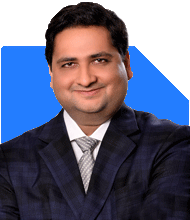Should I invest my life savings in five mutual funds for my 3-year-old son?
Ramalingam Kalirajan |10872 Answers |Ask -Follow
Mutual Funds, Financial Planning Expert - Answered on Oct 14, 2024
He has an MBA in finance from the University of Madras and is a certified financial planner.
He is the director and chief financial planner at Holistic Investment, a Chennai-based firm that offers financial planning and wealth management advice.... more

Hi I wanted to build big corpus for my disabled son who is 3 years old. He don't want work or struggle in his life after my death. I want to invest my life time savings of 60 lacs in lump sum in below mutual fund schemes. And then continue the SIP in all the funds for next 25 years. Please let me know whether I am on right path. 1. ICICI prudential nifty 50 index fund direct growth 2. Parag parikh flexi cap fund direct growth 3. Nippon India small cap fund direct growth 4. ICICI value discovery fund direct growth 5. Quant Midcap fund My combined salary income from my wife and myself is 2.4 lacs we are of same age 33 and mothly expense is around 1 lac. For my retirement I have small agricultural land current worth of 1 crore at present, other savings like ppf, pf, gold , 60 lacs at present and I am going to sell it off all these after 25 years for the retirement expenses for myself and my wife. Above mutual fund money is only for my son . hope my fund selection and above plan is good one .please suggest
Your combined salary of Rs. 2.4 lakh per month and monthly expenses of Rs. 1 lakh give you a comfortable margin for savings. The fact that you are focused on using your Rs. 60 lakh life savings for your son’s future and keeping the agricultural land for your retirement shows that you are clear about your objectives.
However, there are a few things to reassess in your current plan, particularly regarding your fund selection and the potential risks involved.
Reassessing Index Fund Investments
While it may seem that investing in index funds like the ICICI Prudential Nifty 50 Index Fund Direct Growth can give you exposure to the top companies in the country, this approach has certain limitations.
Disadvantages of Index Funds:
Lack of Flexibility: Index funds are passively managed and follow the market index. They cannot adapt quickly during market downturns. So, when markets fall, the fund's value can drop significantly.
No Outperformance: Index funds only aim to replicate the market performance. They don’t strive to beat the market, which can limit the potential for higher returns over time, especially over a long horizon of 25 years. In contrast, actively managed funds can outperform during bullish markets and provide better returns.
No Cushion in Bear Markets: Actively managed funds can cushion market falls by allocating resources into safer stocks or sectors when the market sentiment turns negative. Index funds, on the other hand, have to follow the index, regardless of the market situation.
Assessing Direct Funds
Direct plans of mutual funds usually have lower expense ratios than regular plans, which can translate to slightly better returns. However, there are some disadvantages, especially for long-term and large goals like the one you have for your son.
Disadvantages of Direct Funds:
No Professional Guidance: Direct plans leave you on your own to decide where and how much to invest. While this may seem cost-effective, over 25 years, professional guidance from a Certified Financial Planner (CFP) can be invaluable, especially in dealing with changing market conditions or rebalancing your portfolio.
Difficulties in Managing Portfolio: With multiple direct funds, it can become overwhelming to manage and track the performance of each one. A Certified Financial Planner can help you rebalance your portfolio periodically, ensure proper diversification, and adjust investments based on life changes or market conditions.
Potential to Miss Out on Opportunities: A qualified financial planner can identify growth opportunities, new funds, or even better-performing funds, which may be missed when managing investments independently.
Active Funds as a Preferred Choice
To build a big corpus over a long period of 25 years, actively managed mutual funds tend to perform better than index funds due to the expertise of fund managers in stock selection and timing the market cycles. Here’s why:
Better Returns Potential: Active funds, especially those with a strong track record, aim to outperform the market. Over a long period, this outperformance can result in significantly larger corpus compared to index funds.
Flexibility in Stock Selection: Fund managers can pick and choose stocks that are expected to outperform based on market conditions, industry trends, or specific company performance, which is crucial for long-term wealth creation.
Tactical Rebalancing: Active funds adjust their allocations depending on market cycles and economic changes, which can reduce downside risk and enhance returns.
Evaluating Your Fund Selection
Let’s now evaluate the current funds you’ve chosen for your son’s corpus and retirement goals.
1. Parag Parikh Flexi Cap Fund
Suitability: This fund provides exposure to both domestic and international markets, giving you good diversification. It’s an actively managed fund, and flexi-cap funds can adjust between large, mid, and small-cap stocks based on market conditions.
Risk & Return: The fund can offer strong returns over the long term but has higher volatility than pure large-cap funds. Given your 25-year horizon, this volatility can be managed.
2. Nippon India Small Cap Fund
Suitability: Small-cap funds have the potential for high growth but are also very volatile. Over a 25-year period, these funds can generate strong returns, but they come with the risk of significant fluctuations in the short term.
Risk & Return: Small-cap funds are best suited for aggressive investors with a long-term horizon, like you. However, consider limiting the allocation to small-cap funds due to their high-risk nature.
3. ICICI Value Discovery Fund
Suitability: This fund follows a value-investing approach, which aims to pick undervalued stocks with strong long-term growth potential. This can be a good complement to your portfolio.
Risk & Return: It’s a well-diversified fund that balances risk and reward, and can be part of your portfolio for stable, long-term growth.
4. Quant Midcap Fund
Suitability: Mid-cap funds strike a balance between risk and return. They have more growth potential than large-caps but are less risky than small-caps.
Risk & Return: Over 25 years, mid-cap funds can be a strong contributor to wealth creation. However, like small-cap funds, they are subject to short-term volatility.
Suggested Portfolio Strategy
Given your plan to secure your son’s financial future, you need a well-diversified portfolio that balances growth and risk. Here’s a more balanced approach to your investment strategy:
Recommended Portfolio:
Large-Cap and Flexi-Cap Funds (40%): These funds will provide stability and steady returns over the long term. While large-cap funds focus on blue-chip stocks, flexi-cap funds provide flexibility across all market capitalizations.
Mid-Cap Funds (30%): These funds are ideal for long-term growth and will help boost the overall corpus. However, keep the allocation to a moderate level to balance the risk.
Small-Cap Funds (20%): Small-cap funds can offer explosive growth potential over 25 years but are risky in the short term. Keep this allocation limited to avoid exposing the entire corpus to high risk.
Balanced or Hybrid Funds (10%): To add some stability to your portfolio, consider adding balanced funds that invest in both equity and debt. This will help protect against extreme volatility while providing moderate growth.
SIPs for Long-Term Growth
Since you are also planning to continue with Systematic Investment Plans (SIPs) for the next 25 years, you are on the right track. SIPs will help in averaging the purchase price of units and reduce the risk of investing lump sums at market peaks.
Benefits of SIP:
Rupee Cost Averaging: SIPs ensure you are investing across market cycles, averaging out the purchase price over time.
Disciplined Investment: Regular investments over 25 years will help you accumulate a significant corpus without the emotional burden of market timing.
Retirement Planning for You and Your Wife
Although your focus is currently on securing your son’s financial future, it’s also essential to review your retirement planning. While you have an agricultural land worth Rs. 1 crore, relying entirely on it for retirement could be risky due to market and valuation changes in the future.
Consider diversifying your retirement savings into liquid assets like mutual funds and other safer instruments. A combination of equity and debt mutual funds for retirement can provide stability and growth over time.
Final Insights
You have taken excellent steps toward ensuring financial security for your disabled son. Your decision to invest a significant amount for long-term growth is well thought out. However, it’s crucial to reassess the reliance on index and direct funds and opt for actively managed funds through a certified financial planner. By diversifying your portfolio with a mix of large-cap, mid-cap, and small-cap funds, you can strike a balance between risk and return.
Additionally, continuing SIPs for 25 years is a sound strategy for long-term wealth accumulation. Keep your focus on disciplined investing, and consider adding some hybrid or balanced funds to manage volatility.
Lastly, review your retirement planning and ensure you have adequate liquid assets aside from the agricultural land. This will give you peace of mind, knowing that both your son's future and your retirement are secure.
Best Regards,
K. Ramalingam, MBA, CFP,
Chief Financial Planner,
www.holisticinvestment.in
https://www.youtube.com/@HolisticInvestment
Best Regards,
K. Ramalingam, MBA, CFP,
Chief Financial Planner,
www.holisticinvestment.in
https://www.youtube.com/@HolisticInvestment
You may like to see similar questions and answers below
Omkeshwar Singh | Answer |Ask -Follow
Head, Rank MF - Answered on Dec 21, 2021
Hardik Parikh | Answer |Ask -Follow
Tax, Mutual Fund Expert - Answered on May 03, 2023
Sunil Lala | Answer |Ask -Follow
Financial Planner - Answered on Jan 09, 2024
Ramalingam Kalirajan |10872 Answers |Ask -Follow
Mutual Funds, Financial Planning Expert - Answered on Jul 10, 2024
Ramalingam Kalirajan |10872 Answers |Ask -Follow
Mutual Funds, Financial Planning Expert - Answered on Sep 26, 2024
Radheshyam Zanwar |6735 Answers |Ask -Follow
MHT-CET, IIT-JEE, NEET-UG Expert - Answered on Dec 06, 2025
Dr Nagarajan J S K |2576 Answers |Ask -Follow
NEET, Medical, Pharmacy Careers - Answered on Dec 06, 2025
Mihir Tanna |1090 Answers |Ask -Follow
Tax Expert - Answered on Dec 06, 2025
Ramalingam Kalirajan |10872 Answers |Ask -Follow
Mutual Funds, Financial Planning Expert - Answered on Dec 06, 2025
Radheshyam Zanwar |6735 Answers |Ask -Follow
MHT-CET, IIT-JEE, NEET-UG Expert - Answered on Dec 06, 2025
Radheshyam Zanwar |6735 Answers |Ask -Follow
MHT-CET, IIT-JEE, NEET-UG Expert - Answered on Dec 06, 2025
Radheshyam Zanwar |6735 Answers |Ask -Follow
MHT-CET, IIT-JEE, NEET-UG Expert - Answered on Dec 06, 2025
Dr Dipankar Dutta |1837 Answers |Ask -Follow
Tech Careers and Skill Development Expert - Answered on Dec 05, 2025
Dr Shyam Jamalabad |108 Answers |Ask -Follow
Dentist - Answered on Dec 05, 2025
Dr Shyam Jamalabad |108 Answers |Ask -Follow
Dentist - Answered on Dec 05, 2025





























